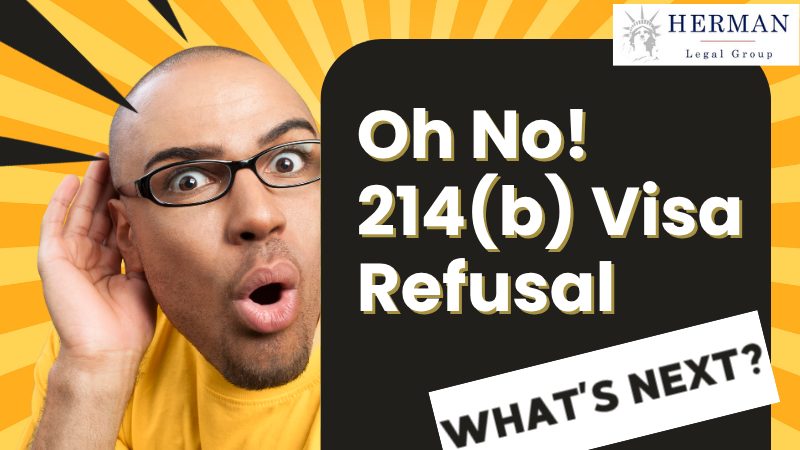Introduction: The Shock of a 214(b) Visa Refusal
If you’ve ever stood before a U.S. consular officer, heard “You do not qualify under Section 214(b),” and saw your passport slide back, you know how it feels — confusing, painful, and unfair.
Every year, millions of visitors, students, and exchange applicants face the same disappointment. Section 214(b) of the Immigration and Nationality Act (INA) creates a legal presumption that every nonimmigrant visa applicant intends to immigrate permanently. Unless you prove otherwise, your application will be refused.
“A 214(b) refusal isn’t the end of your dream — it’s a signal that you need to tell your story differently,” explains Richard T. Herman, Esq., founding attorney of the Herman Legal Group. “If you can show genuine, deep-rooted ties to your home country, you have every chance to succeed next time.”

What Section 214(b) Really Means
Section 214(b) of the Immigration and Nationality Act applies to almost all temporary (nonimmigrant) visa categories — B-1/B-2, F-1, J-1, M-1, H-2B, etc.
According to 9 FAM 402.2-2(B)(1), the law presumes immigrant intent unless the applicant demonstrates to the officer’s satisfaction that they will depart the United States after their temporary stay.
In practice, this means the burden of proof rests entirely on you — the applicant. Nonimmigrant visa applicants must demonstrate that they are not intending immigrants and will return to their home country after a temporary visit. The U.S. Department of State emphasizes that most refusals stem not from missing paperwork, but from failure to demonstrate strong ties.
Understanding “Strong Ties”
As defined in 9 FAM 401.1-3(F), “ties” are the various aspects of a person’s life — employment, family, social relationships, possessions — that bind them to their country of residence.
Examples include:
- Employment: permanent or long-term position, business ownership.
- Family: spouse, children, parents who depend on you.
- Property: land, home, or investments.
- Community: civic, social, or religious commitments.
If the officer doubts those connections, they will refuse under 214(b).
Top 10 Reasons for a 214(b) Refusal
According to 9 FAM 403.10-3(A) and consular training materials:
- Weak family or economic ties.
- Unclear purpose of travel.
- Inconsistent or incomplete answers.
- Lack of prior international travel.
- Family members who overstayed U.S. visas.
- Limited employment or income.
- Vague study or work plans.
- Recent multiple applications.
- Unverifiable financial evidence.
- Perceived intent to work or stay long-term.
The most frequent reason for visa denial is insufficient ties to the home country, which include unstable employment, lack of assets, limited family relationships, weak educational commitments, inadequate financial resources, unclear travel purpose, and poor interview performance.
Important Note:
Officers decide based on a short interview and total impression. Polished honesty and coherent explanation can matter more than thick paperwork.
Can You Appeal a 214(b) Refusal?
No formal appeal or review exists. Under 9 FAM 403.10-3(A)(1), a 214(b) refusal terminates that specific application.
However, you may reapply at any time if your circumstances have materially changed — a new job, marriage, completed studies, or improved finances. The U.S. State Department explicitly warns that submitting identical information will yield the same result.
“Patience pays,” says Herman. “Wait until your life looks different on paper — then the same facts will tell a stronger story.”
How to Strengthen Your Next Application
- Get stable employment. Bring a current employer letter showing salary and approved leave.
- Show property or investments. Ownership documents illustrate long-term planning.
- Provide family evidence. Spouse and children remaining home show strong personal ties.
- Clarify purpose of travel. Present detailed itineraries, invitations, or conference schedules.
- Demonstrate return plans. For students, explain post-study goals at home (9 FAM 402.5-5(E)).
- Be concise and truthful. Consular officers detect memorized or exaggerated stories.
214(b) vs. 221(g): Know the Difference
| Feature | 214(b) | 221(g) |
|---|---|---|
| Reason | Didn’t prove nonimmigrant intent | Missing documents or admin processing |
| Outcome | Denial (must reapply) | Temporary refusal (case can resume) |
| Appeal? | None | Not needed if documents later accepted |
| FAM Source | 9 FAM 403.10-3(A) | 9 FAM 403.10-3(E)(1) |
Special Case: Students and Exchange Visitors
Many F-1 and J-1 applicants are refused under 214(b) because officers doubt their return plans.
Tips for F-1 Applicants
- Provide proof of admission, financial solvency, and clear post-study employment goals.
- Explain how the chosen program fits your career at home (9 FAM 402.5-5(E)(1)).
- Bring evidence of family or business obligations awaiting you.
For official guidance, visit the Student Visa page.
Family in the U.S.: Does It Hurt?
Having relatives in the U.S. doesn’t automatically doom your case, but as noted in 9 FAM 402.2-2(B)(2), officers will weigh whether those connections increase your likelihood of remaining. Disclose relationships honestly; concealment can trigger ineligibility under 212(a)(6)(C)(i).
Balance that with proof of dependents, assets, or duties in your home country.
Expert Insight from Richard T. Herman
“214(b) denials rarely come from missing paperwork,” explains Herman. “They come from weak storytelling — a failure to connect your life’s dots. Build a narrative that says, ‘Here’s who I am, here’s why I’m visiting, and here’s why I’m coming home.’”
He recommends drafting a short written summary of your goals to rehearse before the interview — consistent, honest, and logical.
When to Seek Legal Help
While attorneys cannot attend visa interviews or appeal refusals, they can:
- Audit your prior DS-160 answers for inconsistencies.
- Draft a stronger explanation letter.
- Identify alternative visa categories (e.g., H-1B, K-1, O-1).
- Coach you for next-interview strategy.
Leading Ohio Immigration Law Firms
Ohio hosts several nationally recognized immigration practices that assist clients recovering from 214(b) refusals.
| Firm | Cities Served | Focus Areas |
|---|---|---|
| Herman Legal Group | Cleveland • Columbus • Akron • Youngstown • Cincinnati • Dayton | Comprehensive visa, green-card, and waiver practice; multilingual staff. |
| Margaret Wong & Associates | Cleveland • Columbus | Removal defense and consular processing. |
| Robert Brown LLC | Cincinnati | Employment and family immigration strategy. |
| Sarmiento Immigration Law | Columbus | Student / fiancé / visitor visa preparation. |
| Chodosh & Chodosh LLC | Dayton | Family-based and nonimmigrant reapplications. |
Common Myths About 214(b)
| Myth | Reality |
|---|---|
| “I can never apply again.” | You may reapply once life circumstances change. |
| “I can appeal.” | No appeal exists under 214(b). |
| “I need a waiver.” | No waiver; only stronger evidence works. |
| “My documents decide everything.” | Interview consistency matters equally. |
| “Officers target certain nationalities.” | Consular discretion focuses on individual facts, not nationality (9 FAM 403.10-3(A)(3)). |
Expanded FAQs
1. What exactly is a 214(b) refusal?
A determination that you failed to overcome the presumption of immigrant intent (9 FAM 402.2-2(B)).
2. How soon can I reapply?
Anytime, but without changed circumstances the result will be identical. If denied a visa under Section 214(b), the applicant may reapply at any time by submitting a new application and paying a new visa application fee.
3. Will my previous refusal hurt future applications?
It stays in the record, but strong new evidence offsets it.
4. Can a lawyer attend my interview?
No; see 9 FAM 403.2-3(A)(2) — representatives cannot accompany applicants.
5. Do I pay the fee again?
Yes. Each DS-160 submission requires a new MRV fee.
6. What counts as changed circumstances?
A new job, property purchase, graduation, marriage, or promotion.
7. Can travel history help?
Yes. Returning home on time from prior trips proves credibility.
8. What if my family overstayed in the U.S.?
Disclose truthfully; show your personal reasons to return.
9. Does 214(b) apply to K-1 fiancé visas?
No — K-1 is an immigrant-intent category (9 FAM 502.7-3).
10. Can I switch to another visa type?
Yes, if your purpose changes and you qualify for that category.
11. Can I see the officer’s notes?
You may submit a FOIA request but most notes remain confidential.
12. Will changing embassies help?
Rarely; under 9 FAM 403.2-4(B) officers still consider ties to your home country.
13. Does age or marital status matter?
Indirectly; younger, single people often need stronger economic evidence.
14. What if I was denied for B-2 but now apply for F-1?
You may, but you must convince the officer your intent now aligns with study.
15. Can I email the consulate to reconsider?
Yes, but per 9 FAM 403.10-3(A)(1) reconsiderations are rare.
16. Do U.S. sponsor letters help?
They clarify purpose but cannot substitute for your own ties.
17. Can I apply under Visa Waiver Program after 214(b)?
Maybe; ESTA approval may still be denied due to prior refusal (8 CFR 217.2(b)).
18. Does using a visa consultant help?
Only if they’re honest and experienced; misrepresentation risks permanent bars (INA §212(a)(6)(C)).
19. How can I prove financial stability?
Recent pay slips, tax returns, bank statements, and employer letters are most effective. Improving financial documentation can include providing consistent bank statements, clear funding explanations, and evidence that costs can be covered without unauthorized employment in the U.S.
20. How long should I wait to show change?
Usually 6–12 months or until a major life event occurs.
21. Does a 214(b) denial affect immigrant visa cases later?
No, immigrant petitions are evaluated separately (9 FAM 504.1-3(A)).
22. How can I prepare emotionally?
Treat the interview like a conversation. Stay calm and authentic. Most applicants succeed after learning from their first denial.
Key Takeaways
- A 214(b) refusal means you didn’t prove nonimmigrant intent — not that you lied or failed.
- There’s no appeal or waiver; reapply only after meaningful change.
- Focus on strong ties — job, property, family, education.
- Honesty and clarity win over lengthy documents.
- Legal guidance from experienced immigration lawyers can help structure a winning case.
- Thousands overcome 214(b) each year — with better evidence and confidence.
About Richard T. Herman, Esq.

Richard T. Herman is a nationally recognized immigration attorney and co-author of Immigrant, Inc. He founded the Herman Legal Group over 30 years ago to serve immigrants nationwide with compassion and expertise. The firm’s multilingual team offers strategic counsel for family, business, and student visa cases.
Schedule a confidential consultation at lawfirm4immigrants.com/book-consultation.
References & Resources
- 9 FAM 401.1-3(F) – Definition of “ties.”
- 9 FAM 402.2-2(B) – Presumption of immigrant intent under INA §214(b).
- 9 FAM 402.5-5(E) – Student visa requirements and return expectations.
- 9 FAM 403.10-3(A) – Refusal grounds and procedures.
- 9 FAM 403.2-3(A) – Interview representation rules.
- 9 FAM 403.2-4(B) – Third-country applications.
- 9 FAM 502.7-3 – K-1 fiancé visas (immigrant intent).
- 9 FAM 504.1-3(A) – Effect of nonimmigrant denials on immigrant processing.
- U.S. Department of State – Visa Denials
- USCIS – Immigration and Nationality Act
- CBP – Visa Waiver Program (ESTA)
- FOIA Visa Records Request
- AILA – Find an Immigration Lawyer








